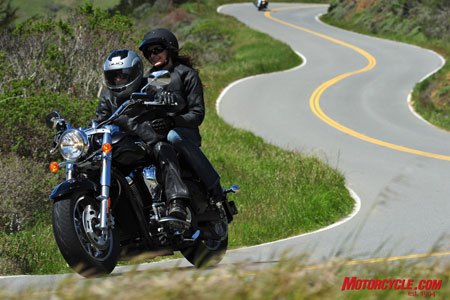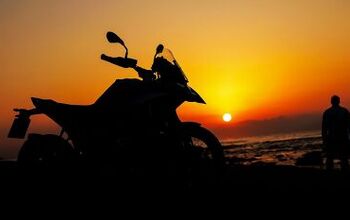2009 Kawasaki Vulcan 1700/LT Review - Motorcycle.com
Get the Flash Player to see this player.
The new Vulcan 1700 is a significant upgrade over the old Vulcan 1600 line, starting with a motor said to offer 20% more horsepower. The new mill is indeed new, not some enlarged version of the old 1552cc “1600.” Kawi says the engine is based loosely on the giant Vulcan 2000, although it uses a single-overhead-cam design with four valves per cylinder instead of the V2000’s pushrods. A 102mm bore was retained from the V1600, but the stroke was stretched from 95mm to 104mm to create an even 1700cc – that’s 103.7 cubic inches for those adverse to the metric system.
The use of a single-pin crankshaft provides the loping sound we’ve come to expect from cruisers, spat out mostly sanitized from stacked, shotgun-style pipes with slash-cut exits. Twin counterbalancers (as opposed to the single balance shaft on the Vulcan 1600) quell vibes from the 52-degree V-Twin. Power production is smoothed out with the addition of Kawasaki’s first electronic throttle valve to the fuel-injection system that adapts to inputs from throttle position, load, temperature and air pressure. If the on-board diagnostic system detects a problem, the ECU can default to one of three fail-safe modes.
The cruiser genre’s currency is big torque, and the new Vulc purportedly has 108 ft-lbs to trade, its peak arriving at just 2250 rpm. Horsepower crests at 4500 rpm. Kawi says the V17 motor produces 15% more torque than the V1600. Even more impressive is a claimed 20% boost in horsepower. Shedding heat is a combination of nicely machined/contoured cylinder finning for air cooling and liquid-cooled upper cylinders.
The Vulcan 1700 platform underpins a line of five semi-distinct iterations for Kawasaki, from the stripped-down boulevardier Classic to the luxury-touring Voyager full-dress tourer. All of them use the same basic engine and chassis. Interestingly, initial development work began on the Voyager, not on the base-model cruiser versions.
| Five Vulcans for 2009: | |
| • Vulcan 1700 Classic: The most basic V17 starts at $12,299 in any color you like as long as it’s Metallic Diablo Black. Ready-to-ride curb weight: 761 lbs. | |
| • Vulcan 1700 Classic LT: A height-adjustable windshield, leather saddlebags, backrest and studded seats increase versatility and raise the MSRP to $13,799. Its warranty is extended from one to two years, and it is available in your choice of two 2-tone paint combinations. Ready-to-ride curb weight: 798 lbs. | |
| • Vulcan 1700 Nomad: Handlebars are pulled back less and floorboards are further back to create a more standard riding position. It’s equipped with a windshield, hard bags, plusher seats and cruise control, resulting in a $14,399 base price. Like the Classic LT, the Nomad is equipped with a 2-year warranty. Ready-to-ride curb weight: 834 lbs. | |
| • Vulcan 1700 Voyager: The top-of-the-line V17 has all of the Nomad’s accoutrements, as well as a large, frame-mounted fairing, comprehensive instrumentation and a top box that can hold two full-face helmets. Prices start at $16,799, bolstered by a longer 3-year warranty. Ready-to-ride curb weight: 886 lbs. | |
| • Vulcan 1700 Voyager ABS: In addition to an antilock braking system, this version uses K-ACT, a linked braking arrangement that uses 4-piston front calipers instead of the 2-piston units on the other V17s. Prices jump $1,100 to $17,899 and includes 3 years of warranty coverage. Ready-to-ride curb weight: 895 lbs. | |
For those of you who appreciate enhanced peace of mind, Kawasaki offers its Good Times Protection Plan that can extend factory coverage by up to four years. Prices depend on which model, and all have no mileage limit.
A new transmission contains an extra cog, gaining an overdrive 6th gear for low-rev freeway cruising. Fifth gear is also overdriven. Gear changes through a heel/toe shifter are fairly light, as is the amount of pull required from the hydraulic clutch. Kawi’s Positive Neutral Finder makes slotting into neutral from a stop as simple as can be, but it does inhibit neutral access while the bike is still rolling.
The new 1700 joins the rest of the belt-driven Vulcan lineup by eschewing the heavy shaft-drive arrangement of the 1600 in favor of a carbon-fiber drive belt that is barely wider than an inch. A belt system has the benefits of being lighter, transmitting more power to the rear tire and not suffering the jacking effect on the rear suspension from a shaft drive. It also makes the bike easier to customize with aftermarket wheels and sprockets.
When cruisers get really big (like the Vulcan 2000 still in the lineup), they inevitably get more ponderous. Thankfully, V17’s chassis is more compact than the old V16, using a new frame that is much wider near the swingarm pivot section. This structural update is said to be 40% more rigid but lighter by 4.4 pounds. Compared to the Vulcan 1600, the V17’s chassis is 30mm shorter, helping to achieve a 13mm reduction in wheelbase to 65.6 inches.
The Vulcan’s maneuverability is aided by sharper steering geometry and tighter ergonomics. Its steering head rake is reduced 2.0 degrees to 30.0 degrees, and comfort is enhanced by a 2-inch reduced stretch to the floorboards and handlebars more than an inch closer to the rider. Its ergos reminded me a bit of Star’s V-Star 1300. We were less enthused with the wide right-side primary cover that forces a rider’s leg to rub against it at a stop, although the exhaust headers are neatly tucked away to avoid roasting of legs.
Evidence of the new chassis comes into focus as soon as when simply motoring away from a parking spot. The 1700 has a natural balance that is a step above some other big-inch cruisers, allowing it to deftly carve tight lines in parking lots or when snapping off a quick, feet-up U-turn on a 2-lane road for another pass by the photographer. Modestly sized 130/90 and 170/70 tires on 9-spoke 16-inch wheels surely aid the bike’s agility.
The big Vulc is no less impressive at higher speeds, responding relatively crisply to a shove on the bars. It’s no ZX-10R, of course, but it reacts willingly to a rider’s inputs. As with any cruiser, especially those with floorboards, twisty-road fun is limited by the amount of cornering clearance. We’re often told cruising riders never complain about restricted lean angles, but I can’t imagine we’re the only ones.
A 43mm Showa damping-rod fork handles front suspension duties. A lack of adjustability is offset by a generous 5.5 inches of travel. Rear-end compliance is supplied by a pair of rear shocks that are air-adjustable up to 43 psi, as well as having rebound damping provisions in four levels. Just 3.1 inches of travel are available, so it’s important to have the right setup. My 145-lb weight didn’t require any air assist, but heavier riders would be wise to air up a bit.
Vulcan 1700 Classic LTBargain hunters might be convinced to overlook the standard Classic in favor of the light-touring LT version. An extra $1,500 buy-in nets you greater comfort, versatility, passenger contentment and a bit of additional bling.
We spent a half a day riding the LT in occasionally blustery conditions, and it was a relief to cower behind a windshield that is adjustable over a 2-inch range. Structurally bolstered leather saddlebags provided stowage for water and a camera, and a backrest keeps your passengers where they belong. The seats are highlighted with chromed brass studs that match the detailing on the saddlebags.
But more obvious to the eyes are the 2-tone paint combos that add considerably to the attractiveness of the black-only Classic. Set against a Pearl Burnish Beige is your choice of two colors: Metallic Nocturne Blue or Metallic Dark Green. Both feature accent pinstriping between the two tones.
Otherwise, the Classic LT has identical features and mechanicals as the pared-down Classic. Its $13,799 MSRP includes two years of warranty coverage to the Classic’s one year. If I were to buy a Vulcan 1700 Classic, I’d definitely choose the LT.
Kawasaki has endowed its latest Vulcan with several small but useful features that make the bike easier to live with. Unlike some heavyweight cruisers, Kawi has thoughtfully integrated a fork lock with the ignition key slot, so there’s no need to poke around for a second key slot or to travel around with a padlock in your pocket. And the ignition switch holds another surprise, as it allows a rider to remove the key once the bike has fired up to prevent a keychain or other keys from marring the nicely embossed metal surface of the ignition surround. Then, when the ride’s over, just twist the ignition ring to the off position and the bike can’t be restarted unless the key is reinserted.
Like most tank-top cruiser instrumentation, the Vulcan’s gauges require a rider’s head to tilt forward in order to see all the info. And there’s plenty to look at here. The instruments include goodies like the range to empty, average mpg, fuel gauge, a gear-position indicator, a clock and twin tripmeters – all controlled by accessible switchgear on the left handlebar. Self-canceling turnsignals are a pleasant addition.
Brakes aren’t a glamorous topic in the cruiser realm, but the Vulcan deserves kudos for its triple-disc setup. Although the twin-piston calipers are low-tech in this age, combined with the large 300mm rotors, they do a surprisingly good job at hauling the Vulcan down from speed. Modulation is quite good, as both tires can readily be howled and kept at that point.
Gaining speed is always more fun than bleeding it, and the 1700cc lump delivers a huge spread of grunt that starts just off idle and doesn’t end until the 6000-rpm rev limiter. In fact, the powerband is so exceedingly linear that it never really provides any real hit, just a steady flow of power that probably comes up a few ponies shy of a Victory or Star Roadliner. That said, its manners are impeccable, exhibiting no driveline lash or throttle-pickup hiccups.
Functionally, we enjoyed the Vulcan’s chassis performance, and its burlier motor is much more enjoyable to twist its throttle than the relatively limp 1600. Plus we were pleased to see the Vulcan equipped with a relatively lengthy list of convenience features.
Yet the Vulcan 1700 stands out more for how it works than how it looks. Not that it isn’t attractive, it’s just that it’s a bit anonymous. A large headlight with a glimmering chrome shroud leads the way in front of an attractive-but-generic teardrop fuel tank. The engine itself it nicely finished with chrome and polished surfaces set off against a matte-black finish. But, judged purely on aesthetics, a Victory Kingpin or Star Roadliner will likely garner a greater number of longing looks.
However, neither of the aforementioned bikes have a list price of just $12,299. A Roadliner Midnight starts at $14,090, while a Kingpin 8-Ball retails for $13,999. A Harley-Davidson Super Glide has a surprisingly low MSRP of $11,999 – it balances its legendary nameplate with fewer features and less power.
Kawi says this line of 1700cc bikes is its future in cruisers, offering “high-performance V-Twins with character and value.” It’s tough to argue with that rationale.
Stay tuned for our review of Vulcan 1700 Nomad and Voyager.
| Highs: | Sighs: | |
| Value Relatively easy to handle Refinement and features | Not the prettiest Not the fastest Not the baddest |
More by Kevin Duke





































Comments
Join the conversation